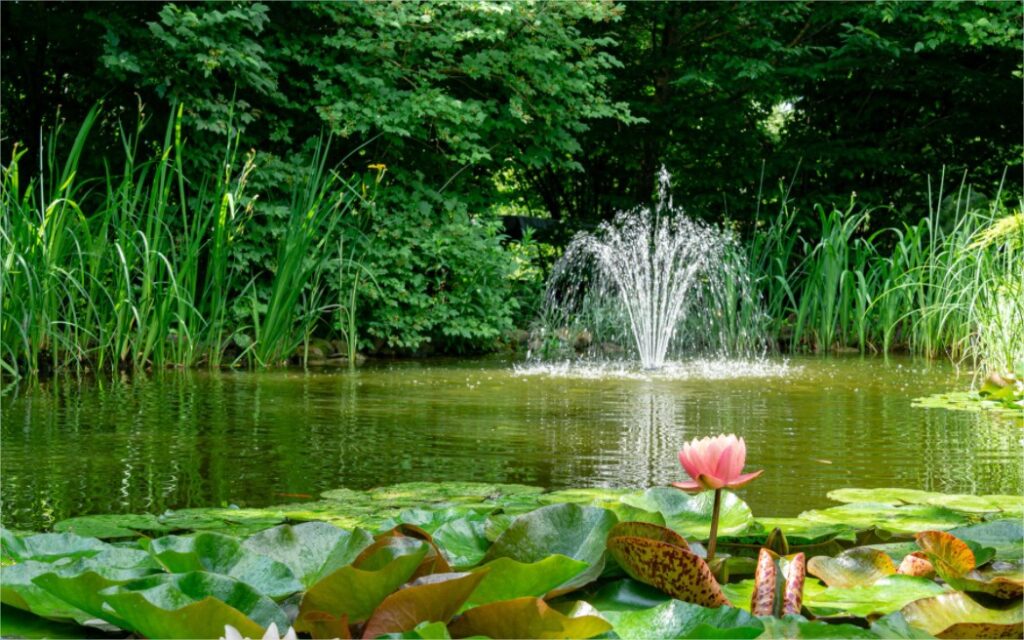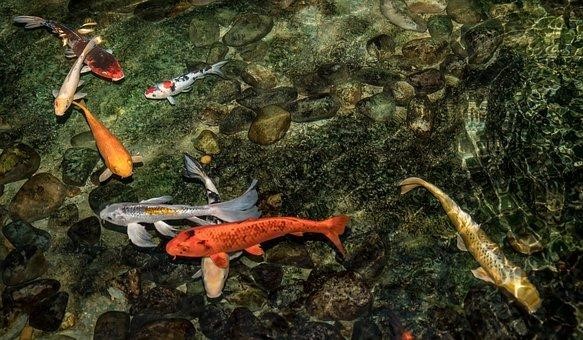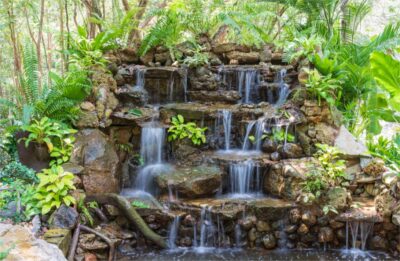Water and wetlands that are cloudy or muddy can be unsightly and potentially harmful. and that’s where the question arises How do I get clear water in my pond
While many swimmers avoid such waters for aesthetic reasons, debris and the unknown can lurk beneath the surface. Broken glass, garbage, and roots, as well as potentially dangerous animals, can easily transform a pleasant afternoon into a disaster. Muddy water is also an issue.

Reduced sunlight penetration can be harmful to marine life, restricting food production for game fish and other aquatic animals.
Having cloudy water is not a rare occurrence for pool enthusiasts. The water is less pure due to the presence of various microscopic particles and dirt, not to mention floating algae. External factors also disturb the biological balance of the pond. However, it is possible to get crystal clear water with these few methods.
Causes of Cloudy Muddy Water
To better handle the water, it’s crucial to figure out what’s causing the cloudiness, or turbidity. Turbidity is an indicator of water clarity a result of suspended solids, algae, or dissolved organic materials. The accumulation of suspended particles, mostly clay, in ponds is the most common source of turbidity.
Since the clay particles are so small, they are constantly coming back in shape as the water temperature, wind, and/or water movement alter.
Soil erosion is the main cause of suspended clay particles. Rainfall runoff has the ability to dislodge clay particles from overgrazed pastures, bare croplands, and uncovered shorelines and carry them across the ground surface to waterways.
Compacted soils, soils with minimal water filtration capability, and soils on moderate to steep slopes are particularly vulnerable to erosion unless a good vegetative or crop residue cover is maintained on the surface.

How To Use a UV Pond Device To Clear Water In My Pond
UV-C radiation is able to eliminate microscopic floating algae. These rays are produced by a fluorescent system placed in a UV device specific for ponds. Water circulates between the equipment housing and a device that surrounds the lamp. UV-C rays destroy the nucleus of algae in the water that passes through the device. It takes two to three days for the water to be clear again. Of course, you need a pump to transfer the water to the equipment.
Treatment products to get clear water in a pond
If you do not prefer to use a UV-C device, it is possible to use water treatment products. They are often effective and have no effect on the health of aquatic animals or plants. Very practical, this type of product is compatible with swimming ponds or large pools. It is important to note that the products that we use for traditional swimming pools are not suitable for ponds. Indeed, they can harm the aquatic biodiversity of the pond.
Skimmers to remove dirt from the water
Almost 70% of the impurities in the water come from the outside. Pollen, leaf residue, dead insects and so on end up in the water. This waste then floats on the surface of the water and settles at the bottom of the basin. The water then turns green and cloudy. During winter, the decomposition of some living organisms can lead to the formation of poisonous gas below the ice sheet and a very poor state for the biological balance of a pond.
To avoid this situation, it i recommend you to quickly remove the dirt floating on the surface of the water. It is possible to use a simple landing net in this case, but resorting to the use of a skimmer is more effective. In fact, it works constantly to ensure that we have good water quality. A skimmer or skimmer removes up to 90% of the impurities present on the surface of the water before they reach the bottom of the pool. Impurities will not have time to decompose in the water. This equipment is essential to avoid pollution.
Mechanical filtration To Get Clear Water In a Pond
The purpose of mechanical filtration is to capture the dirt suspended in the water using a synthetic material such as a sieve. Large particles are retained through the mesh of the filter, while smaller ones pass through them. When this waste collects in the screen, it ends up blocking the passage of water.
It is then necessary to regularly clean the screen filter. Using multiple layers of finer screens can also be very effective. Decantation is also a technique that allows mechanical filtration to be carried out. The principle is simple, heavy particles in suspension fall into the center of a vortex chamber.
The dirt-filled water swirls in the vortex or cyclone. The speed of the water is faster on the outside compared to the center. The heavy particles then pile up in the center in a funnel-shaped container. With well-designed filter designs, this funnel has a drain valve to destroy various impurities.
Biological filtration
Even the finest sieve openings cannot trap even the smallest particles of dirt. It seems that mechanical filtration is not enough to clean the water of all dirt. It does not filter dyes, fish urine, and some chemicals. The purpose of biological filtration is to purify the water with the help of living bacteria.
They have the ability to transform waste into digestible molecules for plants. These wastes usually come from food scraps, dead organisms and fish feces that contain ammonium phosphate. Ammonium, particularly very harmful, is converted into nitrites by bacteria, which in turn are transformed into nitrates, which are not harmful to the health of the fish.
The final product obtained after the transformation of organic materials are nitrate and phosphate, an essential molecule for the development of plants.
The Importance Of Oxygen In Biological Filtration
The different chemical reactions that take place in this context are said to be aerobic, and require the presence of a high level of oxygen. Filters that provide oxygen to the water are therefore more efficient than others. This element can also be supplied by the movement of water through a filter, such as a curved screen or a cylindrical basin air diffuser installed in the filter chambers and connected to an air pump. .









